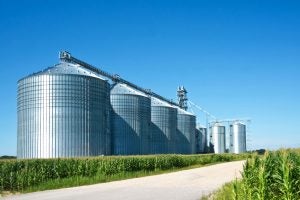When farmers harvest their grain, they can choose to sell it right away or store it to obtain better prices later in the season.
A new study from the University of Illinois Urbana-Champaign explores how Illinois corn and soybean producers make those decisions and why the cost-benefit evaluation of storage may differ across farms.
Agricultural commodity prices fluctuate in response to changes in supply and demand, which depends on the stockpile of grain inventories around the country — but economists don’t really don’t know how farmers decide to sell versus store their grain.
“Economic theory provides guidance that Extension economists have long shared with farmers, but we always say that these decisions depend on the specifics of the farm operation. We haven’t tested the theory against real-world farmer behavior before now. That’s what our paper provides,” said study co-author Joe Janzen, Illinois Extension specialist and assistant professor in the Department of Agricultural and Consumer Economics, part of the College of Agricultural, Consumer and Environmental Sciences.
“Our data show farmers how their peers make marketing decisions and provide useful benchmarking for profitability to help them in their own decision-making. There is great year-to-year variability, and just because a decision is right in general, doesn’t mean it’s right in specific circumstances, so farmers need to be adaptable,” Janzen said.

The researchers plan to develop calculators that farmers can use to understand the costs and benefits of their grain marketing decisions. These tools will also be helpful for business and marketing consultants, extension personnel, and others who serve as advisors for farmers.
For this study, the researchers had access to a large database of farm records from the Illinois Farm Business Farm Management Association. Their analysis focused on corn and soybean producers in Illinois who may hold physical inventories of those commodities on their farm. They collected comprehensive financial statements from nearly 3,000 farms over 18 years.
Agricultural producers put their grain in storage hoping for prices to be higher later in the season. Grain prices usually increase after harvest, but that isn’t always the case. There is a risk to waiting, and the decision to sell or store needs to be weighed against the cost of storage.
“This includes the physical costs of storing and maintaining the grain in good condition, but the bigger cost is that the farm doesn’t have the revenue from selling the commodity,” Janzen stated. “They can’t make new investments as quickly in things that might make their business more profitable — that foregone revenue is a hidden cost that doesn’t necessarily show up as a line item in farm records.”
Economic theory suggests farms that are less capital constrained are more likely to store their grain. In other words, the choice depends on how much they need cash at harvest to cover their expenses.
“Overall, our results indicate that storage costs influence the storage decision, but we find they matter more for some farms than others,” Janzen noted. “When the capital cost for storage increases, the share of production held in inventory decreases. But these findings cover a wide range of behaviors that vary for different farms and economic conditions.”
Some farms are market responsive and make significant adjustments to storage levels based on cost-benefit evaluations. Yet other farms ignore changes in cost and continue to store.
The main determinant for which group they belong to is their overall financial position, which is correlated with size and age. Farms that are bigger and have been in operation for a longer time have more assets and a more stable financial position, and they tend to have lower storage costs, while younger farms are typically in a more precarious financial position, Janzen explained.
The study findings also have broader implications for the role of agricultural commodity storage in the global supply chains.
“For example, last year the water levels on the Mississippi River dropped very low, which constrained shipping and affected agricultural exports. Farmers have to think about whether they are going to change their marketing behavior in response to big supply chain disruptions like that,” Janzen said. “Ultimately, we want to give farmers the tools to become more profitable and more resilient in the face of uncertain markets.”


